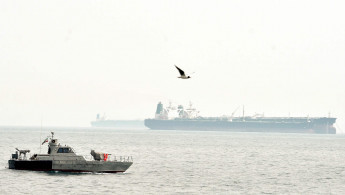Iran offers alternative shipping route for oil after Suez calamity
Iran has put forward an alternative route for transporting oil and goods, after the Suez Canal was blocked for a week.
2 min read
Iran is pushing its transport route [Getty]
An Iranian diplomat has used the Suez Canal blockage as an opportunity to promote Tehran's own transport corridor, saying the link is "cheaper" and "quicker" than the commonly-used Red Sea route.
Kazem Jalali, the Iranian ambassador to Moscow, tweeted on Saturday that the little-known International North-South Transport Corridor (INSTC) in Iran could be another option for shipping oil and goods between Asia and Europe.
He said that using this 7,200km land and sea transport corridor for trade between India and Europe, instead of the conventionally Suez Canal route, could cut 20 days off travel times and decrease costs by 30 percent.
"Therefore, it is a superior option to replace the Suez Canal in transit," Jalali said.
A recent shipping container accident on the Suez Canal caused the waterway to be blocked for a week, with some shipping companies looking to avoid the backlog by sailing around the tip of Africa.
While the blocked ship has been refloated and traffic resumed on the canal, Iran hopes more logistics companies will choose the INSTC to avoid similar shipping delays.
The south section of the route begins in India's Mumbai, with ships docking at Iran's Bandar Abbas port before travelling inland.
The route then passes through Azerbaijan and other parts of the Caucuses before ending its journey in Moscow.
Iran, India, and Russia have invested heavily in the corridor and are hoping more logistics companies will be tempted to use the INSTC after the Suez Canal calamity.
Follow us on Facebook, Twitter and Instagram to stay connected
Kazem Jalali, the Iranian ambassador to Moscow, tweeted on Saturday that the little-known International North-South Transport Corridor (INSTC) in Iran could be another option for shipping oil and goods between Asia and Europe.
He said that using this 7,200km land and sea transport corridor for trade between India and Europe, instead of the conventionally Suez Canal route, could cut 20 days off travel times and decrease costs by 30 percent.
|
|
"Therefore, it is a superior option to replace the Suez Canal in transit," Jalali said.
A recent shipping container accident on the Suez Canal caused the waterway to be blocked for a week, with some shipping companies looking to avoid the backlog by sailing around the tip of Africa.
While the blocked ship has been refloated and traffic resumed on the canal, Iran hopes more logistics companies will choose the INSTC to avoid similar shipping delays.
The south section of the route begins in India's Mumbai, with ships docking at Iran's Bandar Abbas port before travelling inland.
The route then passes through Azerbaijan and other parts of the Caucuses before ending its journey in Moscow.
Iran, India, and Russia have invested heavily in the corridor and are hoping more logistics companies will be tempted to use the INSTC after the Suez Canal calamity.
Follow us on Facebook, Twitter and Instagram to stay connected





 Follow the Middle East's top stories in English at The New Arab on Google News
Follow the Middle East's top stories in English at The New Arab on Google News
![Netanyahu furiously denounced the ICC [Getty]](/sites/default/files/styles/image_330x185/public/2024-11/GettyImages-2169352575.jpg?h=199d8c1f&itok=-vRiruf5)
![Both Hamas and the Palestinian Authority welcomed the ICC arrest warrants [Getty]](/sites/default/files/styles/image_330x185/public/2024-11/GettyImages-2178351173.jpg?h=199d8c1f&itok=TV858iVg)
